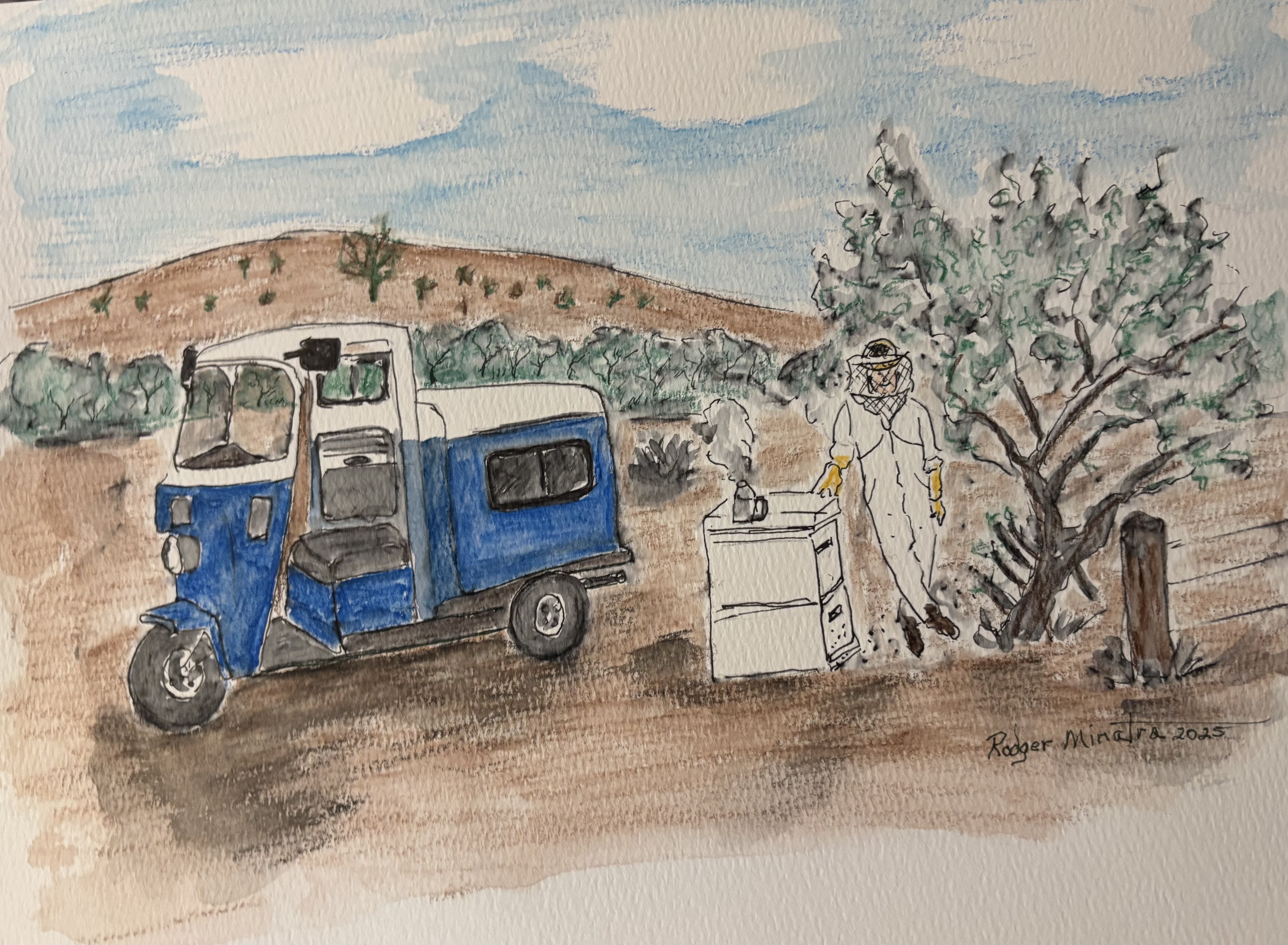Young Beekeeper Memories
A Budding Beekeeper (1960s)
One day while sharing some of my old memories with my granddaughter I thought of the small beekeeping hobby I had growing up in 
Arizona. Later in the day I took a little time to draw a picture using a fountain pen and some watercolor sticks, a new medium for me. I wasn’t trying to be exactly accurate, but wanted to show some of my memories of the old Cushman Mailster, the bee keeper’s gear, and the Arizona desert I have such fond memories of. I built my apiary by collecting spring swarms. I would place an ad in the local paper in early spring telling of my free, bee removal service. Swarming bees were a common occurrence in the desert and it didn’t take me long to build up an apiary of six to ten hives. My dad had purchased three Cushman Mailsters through a government surplus site and one became my transportation, even before I had my license. All the swarms I collected would be transported to the roof of the small apartment behind our home. We lived in town, and it was the only place we could keep them. We had a very high Oleander hedge that surrounded three quarters of our yard and was about 10 feet tall. It provided a little shelter and privacy for what some may have called the Minatra menagerie. I also had rabbits, homing pigeons, a hawk, chickens, a tree squirl, and sometimes milk goats or ponies that would stay the weekend. Like most of my siblings, I have many great memories of that old, pink adobe house.
Most of the swarms I collected were in trees and it was a pretty easy task. All it required was to put a single Honey Super (a bee box) under the swarm, spray them with a little mist of water, then whack the limb very hard. All the bees would drop into the box which would be covered with a lid. If you lost many in the process, you could always leave the box on the ground until evening when they were all together. They would move into the box because that was where the Queen was. She was almost always in the center of the swarm that dropped into the box. Swarming bees are full of honey while they are traveling and are generally pretty docile. I generally wore a vail, but gloves were not always required, it depended on the strain of bees. It was generally an easy and fun process. However, there was this one time…
Like many small towns, my hometown had a small airport just outside of town. It was and is a popular site for parachute training and jumping. The land around the airport was a popular location for hunting, generally rabbits, quail, and dove. The airport had a small vacant building that was once part of the operations. People that knew of this building were also aware that there was a hive of bees located in the wall that were known to be very aggressive. This was before the “killer bees” became a concern in the southern regions of Arizona. As a young beekeeper, I was interested in capturing those bees to add to my apiary. I notified the airport officials and they approved the activity willingly.
My father shared some interest in my beekeeping hobby and decided to help me with this project. When I was a young boy, he and his two brothers removed the honey and bees from a wall in the muffler shop that one of his brothers managed in west Texas, but they were only after the honey, not the bees. They pulled a couple of tin washtubs full of honey and comb out of the wall before exterminating the bees. It made for some good memories, even for a very young, future beekeeper. Of course, there were many stories of my dad’s grandfather who kept bees in west Texas. An interesting note, he would sit in front of the hive at times with his pants leg rolled up so he could get stung. He said it relieved some of his arthritis pain.
When we arrived at the airport with our beekeeping gear, the bees lived up to their aggressive reputation, even from what we thought was a safe distance. We immediately put on our suits and went to work.
Pulling the sheetrock of the inside walls was easy, and what we saw was amazing. There must have been three or four sections of the wall (24-inch centers) that were filled with honeycomb loaded with honey. We pumped the smoker as fast as we could, but it didn’t seem to be making much difference, the bees were furious and showing it. These were small German black bees (my best guess), not like the Italian bee that was common for the area. We started pulling out the comb that was the newest (light colored wax and golden colored honey) and putting it in pots and plastic containers. At the same time, we were keeping a close watch for queen bee. She is generally surrounded by a group of worker bees and has a longer abdomen.
Our Super (bee box) was ready and we were planning to put some of the honeycomb containing larva into the box so the workers could produce a queen if we didn’t find her. We were just pushing some of the comb in the wired frames enough to hold it and then placing it in the box. A few frames were all that was needed. Another frame or two of honey would be added to feed the bees while they were making a new home. Frames (nine to ten per box) are used to separate the comb and allow for easy extraction, but getting the hive started was our only goal at that time.
_w200_h/rod(1)_04181127.jpeg)
